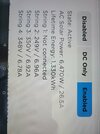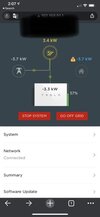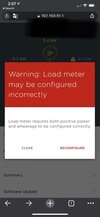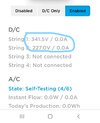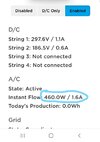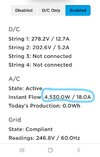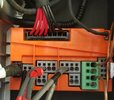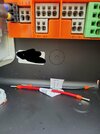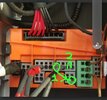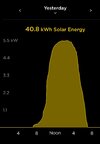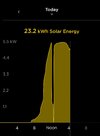Everyone else is trying to fix inverter daily reboot issue, but I have to do manually daily reboot in order to get better power output. Odd?
I spent some time to investigate my system. See attached pictures.
I have 24 panels of 340w but do not know how they are wired. There are two strings, One is high voltage and current, and the other are low in both. In pic1, one string shows 341v open circuit voltage (ocv?), and the other 227v. It's difficult to assign number of panels to the two strings based on those voltages. I am not sure if ocv is 31v for the 340w panels. Pic 2 shows voltage/amp when output is low in the morning. Pic 3 shows those numbers when output is high at noon. In both pictures, output amp seems to be the sum of amp from both strings.
Inverter (7.6kw) panel shows two inputs from solar panels. My system has solar power without PW, and software version is 20.51.2, unlike others with 21.xx.x.
Again, my question is why daily reboot would be required to increase power output for my system.
Educated guess. You said 24 panels with 6 on top level
Based on your ocv and compared to my own
Your string 2 is the 6x panels on top
Your string 1 is the 9x2 panels on lower.
Problem is your string 1. Looks like they parallel it on the roof but didn't parallel it in the inverter.
The Tesla inverter Max out at 13a per mppt you are at 12.7 which is pushing the max. You are losing output because are clipping mppt1
Why is the amp so high? Because the string got parallel on the roof. If you parallel you increase the flow (amp), in a series you increase the voltage. Since your voltage say you have 9 panels in series. But you have 18 panels, ergo you have 2x string of 9 panels parallel in 1 wire. This is ok... But they should have parallel it in the inverter too.
I'm not sure why a reboot would get you more output though....
Disclaimer - not responsible for below, do at your own risk.
Quick fix if you don't want to call and convince Tesla to send a tech out.
Need
a punch/push tool for the terminal block
2x jumper cable (did they leave the one that came right the inverter? About 2-3 inch's u-shape. If not you need a 8-10awg wire
do for both black and red (simplest least steps)
1) shut off inverter preferably do it after dark when no more solar generation so the panels are in a low energy state (safer, but make sure you have enough light to work)
2) insert punch tool to the slot above the wire, that will release the clamp, move string 1 from top row to string 4 at the bottom row
3) jumper 3 and 4 at the top row
That should fix your problem. I will try to add some pictures
2 picture show what to do
1 picture show what the jumper looks like



